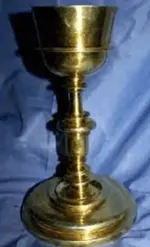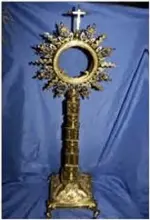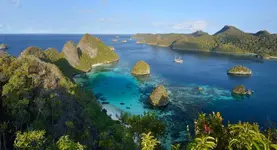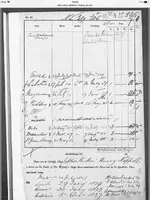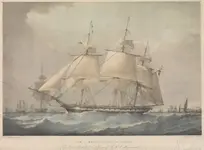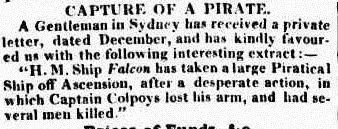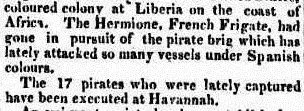Hello Kanacki
Thank you for partnering in the investigation of this true pirate puzzle.
Very nice finding this H.M.S Falcon that captured the pirates.
I also could not find any document showing that H.M.S Magicienne captured pirates and even that pirate escape occurred in southern Brazil.
I will put below an excerpt from the book I wrote, which was based on the letters written by the English citizen, Edward Young Stammers who met the Pirate Zulmiro in 1880 here in my city, Curitiba.

See what Pirate Zulmiro told about this episode:
The oath
Pirate Zulmiro told Edward that they were pursued by a British war ship once. They were in the middle of the Atlantic Ocean and the pursuit lasted several days. Zulmiro was close to escaping, when they were captured by Keppel, the great ship commander, who sank his boat and imprisoned Zulmiro and some sailors who had survived.
Zulmiro was chained and felt the natural fear a criminal has when faced with the possibility of death.
He begged to be heard by Commander Keppel, based on their common heritage, and he confessed he was a British pirate and not a Greek pirate as everyone, including his ship’s crew, had thought.
When Commander Keppel learned the pirate he had captured was British, he went to the ship’s hold to examine the story closer.
Zulmiro sought by all means to catch the commander’s attention and gain his sympathy, by speaking only in English and reminding him of the facts that bound them, as they had been great friends in the past, at the time when Zulmiro was an officer in the British Royal Navy.
When Commander Keppel recognized the pirate, he became deranged and wanted to kill Zulmiro with his bare hands.
Keppel said he should have blown Zulmiro’s ship to smithereens, and Zulmiro should have died at that very instant. After some time, when he was calmer, he called Zulmiro a coward and a traitor, and said he would be hanged with his sailors.
On the following day, Zulmiro was taken to Commander Keppel’s cabin and freed from his chains.
After being silent for a long time and staring at his friend, who had become a pirate, Keppel asked Zulmiro if he still knew how to swim like he did when they used to go swimming in the Thames River.
Zulmiro did not answer and kept quiet. Keppel told Zulmiro to listen carefully to the information he was about to give him, as he would simulate his friend’s escape.
Keppel was upset when he saw what Zulmiro had become, but he would not be the executioner who punished his old mate’s crimes. Zulmiro nodded his head, and Keppel explained his plan.
That night, he would maneuver to approach the Brazilian shore, and, at daybreak, he would disembark with the excuse of wanting to know where the pirate has hidden his treasure, and he would take Zulmiro with him.
Once they arrived on the beach, they would go into the woods, and Zulmiro would have half an hour to escape inside the continent.
After this, Keppel would call his crew and, pretending to be very upset, he would order his crew to go after the runaway criminal.
At that moment, Keppel told Zulmiro to listen carefully. He was supposed to head to the backwoods of the continent, where he should live far from the civilized world and towns. He should never go to the sea, the miserable stage of the horrific scenes in of his pirate life.
Pirate Zulmiro swore to Commander Keppel he would do that, and, on the following day everything went according to their plan.
When the two parted, Keppel gave Zulmiro fifty pounds so he would not starve, along with the four small books the pirate took with him, with which he tried to ease the loneliness of his days.
It took pirate Zulmiro nine days to climb the mountain and arrive at that place where he was able to buy his shed. He remained there, living in isolation and with no contact with residents in the town of Curitiba.
________________________________________________________________
Henry Keppel was 1st Lieutenant at this time, already a shipboard officer.
I believe that Edward Young, who wrote these letters 16 years after the meeting with Pirate Zulmiro, may have added some information to the pirate's account, which he remembered, as Keppel was not the ship's captain, but as an officer. on board the ship had command voice too.
The interesting thing was that I was able to locate the Pirate here in Curitiba, and all dates match, he was 81 years old in 1880 and died at 90 years old in 1889.
And this English immigrant (Pirata Zulmiro) who lived up to 90 years here in Curitiba, is not registered in the Brazilian immigration books.
Here in town he was known as the old Englishman who lived in the woods.



